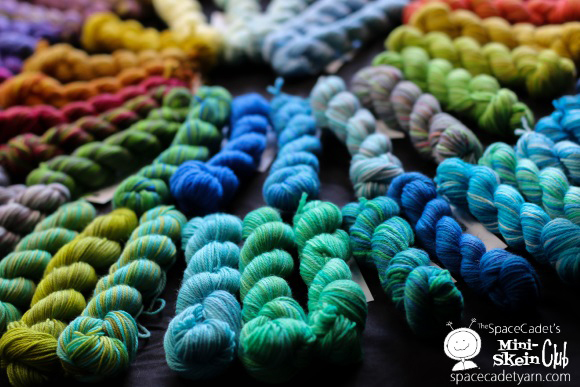As consumers caught on to the retail clubs’ hidden fees and charges, the business model faded away.
Over the past decade, entrepreneurs have reincarnated the notion of retail clubs. This time around, however, the business model has more transparency for consumers. When Birchbox, the 2010 startup that sells $10 boxes of curated beauty samples, became wildly successful — the company was valued at $485 million in 2014, according to VentureBeat.com — others jumped on the subscription-box bandwagon.
Consumers can now buy anything from food to toys through subscription box services, and craft/sewing/hobby subscriptions are popular. Those who have started subscription box services enjoy the (mostly) regular monthly income generated from this business model.

The most recent Quilty Box featured Heather Givans from Crimson Tate.
Photo courtesy of Quilty Box
For those looking to start a craft box subscription service, the first key to success is to offer products that have a value higher than the monthly subscription cost.
“It’s gotten to the point where I can almost predict which ones won’t stick around based on their initial debut,” says Wendy Rose, who operates the subscription review website 2 Little Rosebuds. “The ones that tend to fail are boxes that don’t have a lot to offer subscribers product-wise or value-wise.”
Stephanie Alford, of Space Cadet started her hand-dyed yarn business in 2010 and developed her first subscription club one year later. She provides value by using the highest quality yarns and dyes, offering color combinations that surprise her subscription box consumers each time. She also sends “awesome gifts” to subscribers, such as personalized Yarnit bowls that keep skeins neat and organized. Alford’s customers say they value her personal touches.

Mini skeins from Space Cadet.
Photo courtesy of Stephanie Alford
But as the market for subscription boxes has become saturated, according to an article on AmericanExpress.com, it is “crucial to differentiate your service from others already out there.”
Morgan Spenla differentiates her business, The Crafter’s Box, from other services by providing an online maker and membership community for those who want to create “grown-up crafts.” Customers receive more than just a box of supplies — they can watch videos and chat online with the featured maker of the month.
Any subscription service’s product needs to be backed up with a user-friendly website and a marketing strategy that includes social media, social media and more social media.
Patrick Claytor, who has a background in computer programming and engineering, discovered Quilty Box and purchased a subscription for his mom. He realized it could be a profitable venture, and bought the business from the previous owner in February of 2015.
“I was looking for a gift and didn’t know what kind of quilting supplies to get for my mom,” Claytor says, laughing at the memory. “Now I have to get quilt supplies for everyone!”
Not only is his website user-friendly, but he relies heavily on social media to spread the word. His happy customers are more than willing to share.
Vickie Carmichael takes videos of her Quilty Box “unboxings” and posts them on her YouTube channel. She says she loves filming the unboxings, and they help build Claytor’s business, too.
Potential business owners without Claytor’s computer programming savvy can turn to services like CrateJoy to help build their site, but they’ll also need to be prepared for other tricky aspects of the business, like sourcing, fulfilling orders and meeting customer service needs.
For Spenla, those other aspects of the subscription-box business proved more complicated than she had imagined. Weather, for instance, can wreak havoc on deliveries, so a customer service member has to be willing to communicate any unforeseen issues to members.
And, of course, there’s always that little issue of cash flow. Potential business owners must possess the ability to plan far, far ahead, Alford says.

Patrick Claytor of Quilty Box.
“Two of my clubs have people pay six to 12 months in advance,” Alford says. “I am taking their money with the promise to deliver for the next 12 months. You have a couple hundred people, and take a couple hundred dollars from each, and that’s a huge influx of money they’re trusting you with.”
So Alford keeps her money in separate accounts, and the subscription fees don’t remain part of her working capital. She doesn’t touch that money until that month’s shipment is sent. Only then, does she move the profit into her working account.
“That way, if I get hit by a bus, my poor grieving husband can refund everyone,” Alford says, jokingly.
Taking a more serious tone, Alford adds that many subscription services “go belly up” because they failed to protect that influx of cash.
As with any type of business, planning, good money management, creativity and great customer service are key. But subscription box services have their own special appeal.
“I think people enjoy subscription boxes for the same reasons I do,” Rose, of 2 Little Rosebuds, says. “They’re often a good value, convenient, and who doesn’t love getting a package in the mail?”
Interested in learning more about running a subscription box? Tune into our webinar with subscription box coach, Moira Fuller.

Deanna McCool
contributor

We have really enjoyed working with the Quilty Box team on one box and getting to know them as people. Glad to see they were able to help with this article and to see us all sharing. May they continue to have success and introduce the quilters of the world to new products and projects opening new demand opportunities for quilt shops and innovators.